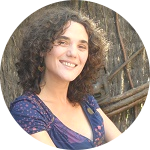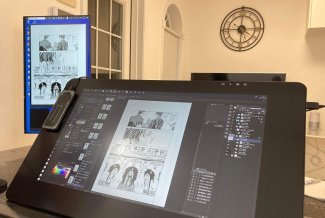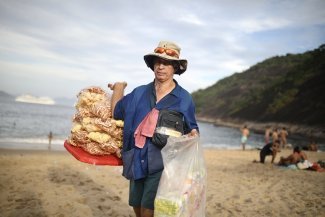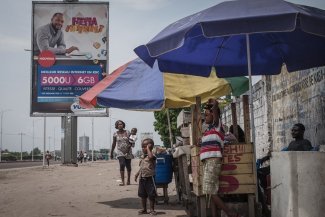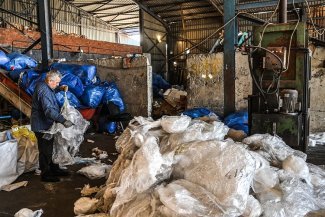In early November, the Argentine doctor Damián Verzeñassi witnessed how the deanery of the National University of Rosario decided to use chains to lock up the office holding over 96,000 medical records of residents from four Argentine provinces, who, according to Verzeñassi’s research, are suffering from ailments that did not exist in the region before the arrival of the multinational companies Monsanto and Bayer.
The deanery’s decision, which the doctor described as an act of persecution, came just days after the academic took part in the first “International Monsanto Tribunal” (IMT, a civil society initiative), held in The Hague. Verzeñassi had testified as a doctor at the people’s tribunal against the US company Monsanto.
Verzeñassi denounced dean Ricardo Nidd for “launching a campaign of ideological and academic persecution against teaching staff and students who have been supporting “families suffering from the dominant agribusiness model, with its GM crops and agrochemicals”, and explained that the campaign was backed by “provincial officials and agribusiness companies”.
Civil society was quick to react and a group of grassroots organisations, environmental associations and NGOs made an open and public declaration condemning the measures taken against Verzeñassi. A group of academics supported the researcher and compared his case to that of the late Andrés Carrasco, one of the first scientists in Argentina to prove the dangers of glyphosate. Now recognised and remembered, Carrasco faced a harsh response to his criticism of the soy model – now the mainstay of the Southern Cone economies.
Around 60 per cent of Argentina’s arable land, a similar percentage in southern Brazil, and almost 80 per cent in Paraguay, is already planted with soy, which is virtually all genetically modified. In 2003, Syngenta published adverts in the rural supplements of Argentina’s two best selling daily newspapers in which it referred to the Southern Cone countries that have seen the spread of the “new green gold” – Brazil, Argentina, Uruguay, Paraguay and Bolivia – as the “United Republic of Soybeans”.
The term was subsequently adopted by agribusiness opponents, characterising it as an expression of neocolonialism, which confines Latin America to the role of exporting low-value-added raw materials – in this case, genetically modified soy, produced using biotechnology from rich countries and exported to China to feed pigs, or to Europe to produce biodiesel.
The most widespread version is the soy patented by Monsanto, Intacta, known for its resistance to one of the world’s best selling agrochemicals, Roundup Ready, which contains glyphosate. This is the “technological package” sold to producers and that guarantees the monoculture’s yield. In 2013, Argentina used 320 million litres of glyphosate, according to the Red Universitaria de Ambiente y Salud (Environment and Health University Network – REDUAS); in 2000, the figure was 145 million litres.
According to REDUAS, 22 million hectares are affected by the substance, along with 13.4 million people, either directly or indirectly.
For the engineer and academic Walter Pengue, the soy model is part of a “neocolonial” system whereby countries from the South export their wealth to rich countries. Pengue has tried to quantify the nutrients and the water lost due to the export of soybeans: “Global agricultural trade can be viewed as a huge transfer of water, in the form of raw materials, from regions where it is found in relative abundance and at a low cost, to others where it is scarce, costly, and its use competes with other priorities,” says the academic, who describes the region’s soyification as a “machine producing hunger, deforestation and socio-ecological devastation”.
Mothers stand up against toxic agrochemicals
There is no longer any dispute about the damage to ecosystems. A recent study by Argentina’s National Scientific and Technical Research Council, Conicet, has confirmed that the Parana River Basin has been polluted with glyphosate. There is also overwhelming evidence about its impact on health, thanks to the work conducted by Verzeñassi and the network of doctors from fumigated towns, Red de Médicos de Pueblos Fumigados, who have identified a rise in the number of cancer and leukaemia cases, foetal malformations and miscarriages. The scientific evidence is also growing: in October 2016, biochemists from the National University of Rosario detected learning and memory deficits in nervous cells exposed to glyphosate.
Monsanto, meanwhile, continues to claim that glyphosate is harmless, despite it being included in the World Health Organisation’s (WHO) list of potentially carcinogenic substances.
It was social resistance to glyphosate that pushed the scientific community to conduct studies challenging the version presented by multinationals and the governments of the day. Reports started to emerge in producer countries of increases in genetic malformations, miscarriages and cancer in areas close to crops. The most emblematic fight was perhaps that of the Mothers of Ituzaingó Anexo, a neighbourhood on the outskirts of Cordoba, where women led the opposition to soy.
“We started to see an increase in certain ailments, and initially we thought it was because of the water. But then we managed to get help from experts and we were able to establish that the cause of our problems was the glyphosate,” explains one of the activists.
The people at the epicentre of soy expansion in Cordoba have demonstrated their opposition to a development model that constitutes a threat to their health and their future. Monsanto had chosen the Córdoban town of Malvinas Argentinas as the site for its new seed manufacturing plant, but after a two-year protest camp, the multinational finally gave up in August 2016. The members of the Self-Convened Assembly of Acampe have nonetheless decided to remain on site until they are sure the land is indeed going to be divided into plots, as announced, with a view to developing an industrial park for SMEs.
Indigenous people face the biggest loss
Those losing out the most from the soy-based development model are indigenous peoples, as the crop’s expansion is taking place on their lands. Qom people in the Argentinian provinces of Chaco and Formosa have denounced the growing pressure, harassment and attacks linked to the advance of soy, according to investigations such as those carried out by journalist Darío Aranda.
Some 3000 people from the Guaraní-Kaiowá tribe living in the Brazilian state of Matto Groso do Sul are faced with harassment from illegal armed groups and the inaction of a state that has failed to fulfil the commitment made in 2009 to demarcate their lands, as denounced by FIAN International. In 2012, an open letter from a Guaraní community threatening to commit collective suicide if they were evicted from their lands caused alarm at the time, but nothing has changed since then: the Guarani people continue to be threatened by the spread of monoculture and other extractive industry projects, such as megadams, which prevent them from pursuing their traditional way of life.
In Paraguay, the spread of soy is a threat to both the Guarani people and small farmers, in a country where the crop has already taken over 80 per cent of arable land, and where two per cent of the population owns 85 per cent of the land. The expansion of agribusiness has been linked to the deaths of 115 campesinos since the end of the dictatorship in 1989, as highlighted by Oxfam.
The country’s soyification is, moreover, one of the main causes of the deforestation of Paraguay’s Atlantic Forest, the surface area of which has shrunk by 85 per cent: just 1.3 million hectares are left of the original 9 million, according to WWF.
At the civil society trial held in The Hague, Monsanto was accused of violating indigenous peoples’ rights. The company has denied the accusations. “The mock trial distracts from real dialogue on the world’s food and agriculture needs and the full realization of human rights,” said the company in an open letter, in which it also emphasised the actions being taken to “enhance honey bee health” and to “prevent illegal deforestation and protect local species”.
The soy consensus
Despite the growing opposition in academic circles and the areas directly affected by fumigation, there is still a consensus among the political class regarding soy, Argentina’s main source of foreign income: revenues from the export of soy derivatives totalled US$158 billion between 2002 and 2013. Uruguayan intellectual Raul Zibechi sums up the situation as follows: “The cultivation of soy grew exponentially during the Kirchner years; the difference is that they provided more social rewards for the poorest 50 per cent than right-wing governments”, whereas one of the first measures taken by Mauricio Macri’s neoliberal government, which came to power in December 2015, was to cut export taxes for soy companies.
Recent weeks have seen controversy between Monsanto and the Macri government, but the dispute is not over the expansion of soy, but the fees Monsanto imposes on producers. A large proportion of producers in Argentina do not use the soy patented by Monsanto but similar ones, which the company charges fees or royalties on through individual contracts, the legitimacy of which producers have challenged.
The Agriculture Ministry, with Macri’s approval, has taken the producers’ side. To step up the pressure, Monsanto has announced plans to suspend the launch in Argentina of the new Roundup Ready 2 Xtend soybeans and has threatened the government with what hurts the most: the undermining of investor confidence.
In the meantime, opposition to Monsanto is still failing to find a place in the headlines or on the government’s agenda but it is being strengthened on the ground.
As researcher Mauricio Berger, who specialises in environmental justice, explains: “I think this fight will take on an anti-capitalist turn, because we are getting to the root of the problem: this is a model that creates development for a privileged few and causes damage to the health and the environment of minority groups. Alternatives are starting to emerge, alternative models, ways of fighting and methods of self-organisation are being developed, such as the assemblies and the exchanges that emerged with the 2001 crisis and are still there, lying dormant.”


